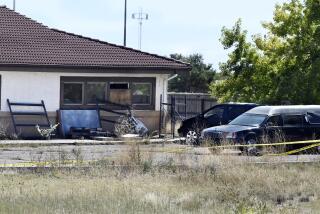Richard III site: Coffin inside a coffin, and a skeleton inside that
It’s the Leicester parking lot that just keeps giving.
Last summer, archaeologists discovered the long-lost remains of King Richard III, buried beneath a nondescript parking lot in the English town of Leicester.
This summer, the same team returned to the site and discovered something more puzzling: A medieval coffin of lead, buried inside a medieval coffin of stone.
And inside the lead coffin they found a human skeleton — its knobbly feet jutting out out from a hole at the bottom of the coffin. (See the photo gallery above).
Archaeologists, who discovered the double coffin last week, are still not quite sure what to make of it.
“None of us in the team have ever seen a lead coffin within a stone coffin before,” said site director Matthew Morris of the University of Leicester in a statement. “We will now need to work out how to open it safely, as we don’t want to damage the contents when we are opening the lid.”
In the photos above, you will see that it took eight men just to remove the lid from the stone coffin.
Neither of these discoveries were pure coincidence, of course. Centuries before the parking lot served drivers parking near the Leicester City Council Social Services, it was the site of the Priory of the Grey Friars, which was founded in 1255, according to researchers at the University of Leicester.
King Richard III, who ruled England for just two years, was buried at the church after his death on the battlefield in 1485. An alabaster stone monument erected by his successor King Henry VII marked his grave. But the friary was dissolved in the 16th century by Henry VIII, and demolished in 1538. After that, the final resting place of King Richard became a mystery.
Richard III horror story: Axed in head, stabbed in rear, bones dug up
In 1986, University of Leicester tutor David Baldwin made a compelling argument that the Grey Friars monastery was indeed where Richard was buried, and that it was at this particular spot in Leicester, but it took more than 25 years before enough interest and money could be raised to start an excavation.
King Richard’s skeleton was discovered in August of 2012, and in February of 2013, archaelogists were able to prove beyond a shadow of a doubt that the bones were in fact his.
Now they will turn their attention to discerning who lies in the nesting caskets. They believe it is a person of prominence and that it could be one of two leaders of the English Grey Friars order — Peter Swynsfield (d. 1272) or William of Nottingham (d. 1330). Another name mentioned in the release is Sir William de Moton of Peckleton, a 14th century knight.
Or it could be someone entirely different. The mystery continues....







